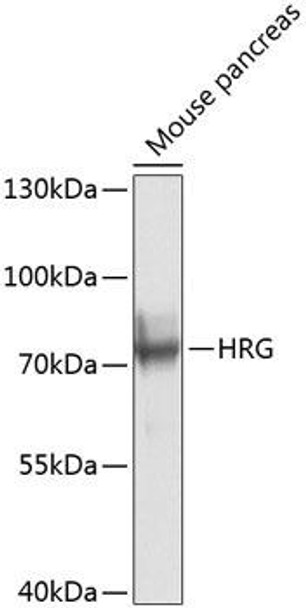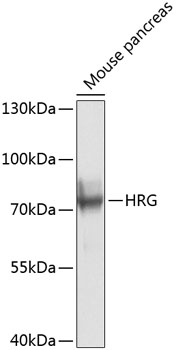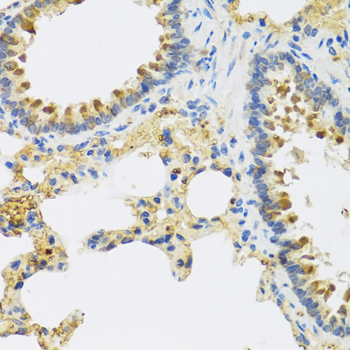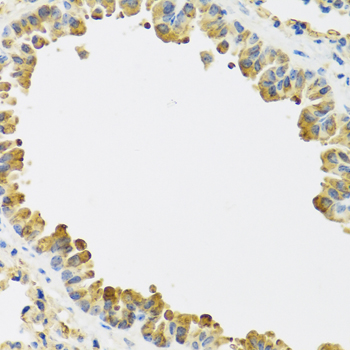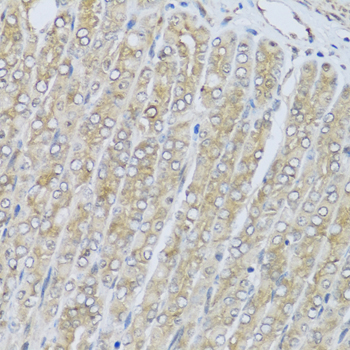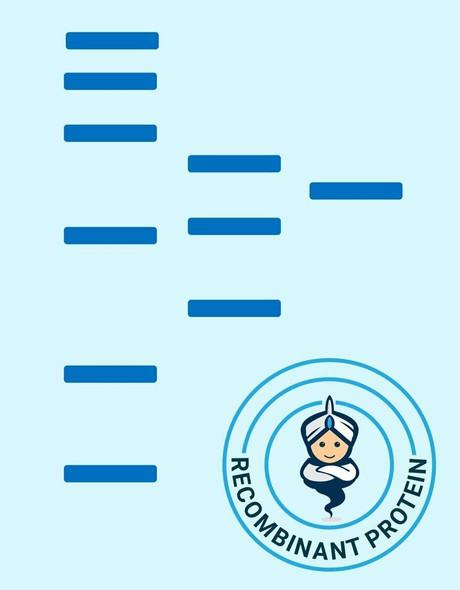Anti-HRG Antibody (CAB8431)
- SKU:
- CAB8431
- Product type:
- Antibody
- Application:
- WB
- Application:
- IHC
- Reactivity:
- Mouse
- Rat
- Host Species:
- Rabbit
- Isotype:
- IgG
- Research Area:
- Cardiovascular
Description
| Antibody Name: | Anti-HRG Antibody |
| Antibody SKU: | CAB8431 |
| Antibody Size: | 20uL, 50uL, 100uL |
| Application: | WB IHC |
| Reactivity: | Mouse, Rat |
| Host Species: | Rabbit |
| Immunogen: | Recombinant fusion protein containing a sequence corresponding to amino acids 20-260 of human HRG (NP_000403.1). |
| Application: | WB IHC |
| Recommended Dilution: | WB 1:500 - 1:2000 IHC 1:50 - 1:100 |
| Reactivity: | Mouse, Rat |
| Positive Samples: | Mouse pancreas |
| Immunogen: | Recombinant fusion protein containing a sequence corresponding to amino acids 20-260 of human HRG (NP_000403.1). |
| Purification Method: | Affinity purification |
| Storage Buffer: | Store at -20°C. Avoid freeze / thaw cycles. Buffer: PBS with 0.02% sodium azide, 50% glycerol, pH7.3. |
| Isotype: | IgG |
| Sequence: | SPTD CSAV EPEA EKAL DLIN KRRR DGYL FQLL RIAD AHLD RVEN TTVY YLVL DVQE SDCS VLSR KYWN DCEP PDSR RPSE IVIG QCKV IATR HSHE SQDL RVID FNCT TSSV SSAL ANTK DSPV LIDF FEDT ERYR KQAN KALE KYKE ENDD FASF RVDR IERV ARVR GGEG TGYF VDFS VRNC PRHH FPRH PNVF GFCR ADLF YDVE ALDL ESPK NLVI NCEV FDPQ EHEN INGV PPHL G |
| Gene ID: | 3273 |
| Uniprot: | P04196 |
| Cellular Location: | Secreted |
| Calculated MW: | 59kDa |
| Observed MW: | 80kDa |
| Synonyms: | HRG, HPRG, HRGP, THPH11 |
| Background: | This histidine-rich glycoprotein contains two cystatin-like domains and is located in plasma and platelets. The physiological function has not been determined but it is known that the protein binds heme, dyes and divalent metal ions. The encoded protein also has a peptide that displays antimicrobial activity against C. albicans, E. coli, S. aureus, P. aeruginosa, and E. faecalis. It can inhibit rosette formation and interacts with heparin, thrombospondin and plasminogen. Two of the protein's effects, the inhibition of fibrinolysis and the reduction of inhibition of coagulation, indicate a potential prothrombotic effect. Mutations in this gene lead to thrombophilia due to abnormal histidine-rich glycoprotein levels. |
| UniProt Protein Function: | HRG: Plasma glycoprotein that binds a number of ligands such as heme, heparin, heparan sulfate, thrombospondin, plasminogen, and divalent metal ions. Binds heparin and heparin/glycosaminoglycans in a zinc-dependent manner. Binds heparan sulfate on the surface of liver, lung, kidney and heart endothelial cells. Binds to N-sulfated polysaccharide chains on the surface of liver endothelial cells. Inhibits rosette formation. Acts as an adapter protein and is implicated in regulating many processes such as immune complex and pathogen clearance, cell chemotaxis, cell adhesion, angiogenesis, coagulation and fibrinolysis. Mediates clearance of necrotic cells through enhancing the phagocytosis of necrotic cells in an heparan sulfate-dependent pathway. This process can be regulated by the presence of certain HRG ligands such as heparin and zinc ions. Binds to IgG subclasses of immunoglobins containing kappa and lambda light chains with different affinities regulating their clearance and inhibiting the formation of insoluble immune complexes. Tethers plasminogen to the cell surface. Binds T-cells and alters the cell morphology. Modulates angiogenesis by blocking the CD6-mediated antiangiongenic effect of thrombospondins, THBS1 and THBS2. Acts as a regulator of the vascular endothelial growth factor (VEGF) signaling pathway; inhibits endothelial cell motility by reducing VEGF-induced complex formation between PXN/paxillin and ILK/integrin-linked protein kinase and by promoting inhibition of VEGF-induced tyrosine phosphorylation of focal adhesion kinases and alpha-actinins in endothelial cells. Also plays a role in the regulation of tumor angiogenesis and tumor immune surveillance. Normalizes tumor vessels and promotes antitumor immunity by polarizing tumor-associated macrophages, leading to decreased tumor growth and metastasis. Defects in HRG are the cause of thrombophilia due to histidine-rich glycoprotein deficiency (THPH11). A hemostatic disorder characterized by a tendency to thrombosis. |
| UniProt Protein Details: | Protein type:Secreted; Secreted, signal peptide Chromosomal Location of Human Ortholog: 3q27 Cellular Component: plasma membrane; extracellular region Molecular Function:heparin binding; serine-type endopeptidase inhibitor activity; heparan sulfate proteoglycan binding; protein binding; zinc ion binding; metal ion binding; heme binding; immunoglobulin binding; cysteine protease inhibitor activity; receptor binding Biological Process: platelet activation; positive regulation of apoptosis; positive regulation of immune response to tumor cell; negative regulation of cell adhesion; negative regulation of blood vessel endothelial cell migration; chemotaxis; response to organic cyclic substance; negative regulation of cell proliferation; fibrinolysis; negative regulation of angiogenesis; negative regulation of fibrinolysis; platelet degranulation; positive regulation of focal adhesion formation; regulation of gene expression; regulation of actin cytoskeleton organization and biogenesis; regulation of blood coagulation; regulation of protein complex assembly; angiogenesis; negative regulation of cell growth; blood coagulation; regulation of peptidyl-tyrosine phosphorylation; defense response to fungus; negative regulation of cell adhesion mediated by integrin Disease: Thrombophilia Due To Histidine-rich Glycoprotein Deficiency |
| NCBI Summary: | This histidine-rich glycoprotein contains two cystatin-like domains and is located in plasma and platelets. The physiological function has not been determined but it is known that the protein binds heme, dyes and divalent metal ions. The encoded protein also has a peptide that displays antimicrobial activity against C. albicans, E. coli, S. aureus, P. aeruginosa, and E. faecalis. It can inhibit rosette formation and interacts with heparin, thrombospondin and plasminogen. Two of the protein's effects, the inhibition of fibrinolysis and the reduction of inhibition of coagulation, indicate a potential prothrombotic effect. Mutations in this gene lead to thrombophilia due to abnormal histidine-rich glycoprotein levels. [provided by RefSeq, Nov 2014] |
| UniProt Code: | P04196 |
| NCBI GenInfo Identifier: | 123523 |
| NCBI Gene ID: | 3273 |
| NCBI Accession: | P04196.1 |
| UniProt Secondary Accession: | P04196,B9EK35, D3DNU7, |
| UniProt Related Accession: | P04196 |
| Molecular Weight: | 59,578 Da |
| NCBI Full Name: | Histidine-rich glycoprotein |
| NCBI Synonym Full Names: | histidine-rich glycoprotein |
| NCBI Official Symbol: | HRG |
| NCBI Official Synonym Symbols: | HPRG; HRGP; THPH11 |
| NCBI Protein Information: | histidine-rich glycoprotein; histidine-proline-rich glycoprotein |
| UniProt Protein Name: | Histidine-rich glycoprotein |
| UniProt Synonym Protein Names: | Histidine-proline-rich glycoprotein; HPRG |
| UniProt Gene Name: | HRG |
| UniProt Entry Name: | HRG_HUMAN |

